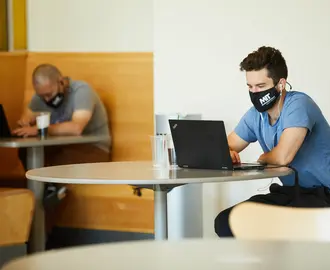Monday Okoro, SF ’07
“You cannot drill oil from home.” The quip from Monday Okoro, SF ’07, vice president of Schlumberger Production Management, sums up the complexity of the issues facing companies like his whose operations require the physical presence of a vast workforce. Multinational petrol giant Schlumberger employs 85,000 people in 80 countries. Devising new policies and practices in response to the pandemic, therefore, requires far greater effort than a few tweaks to the employee handbook.Okoro isn’t daunted by the challenge. He boils the problem down to its basics. “If we always—always—consider safety first, well-being first, then we know we have the right policies.,” he says. “They may vary a bit from country to country, culture to culture, but if health and safety are at the root, we have the right policies in place.”
The top priority has been communicating crucial safety protocols to a workforce that stretches across continents, from global hubs to remote hamlets. The first step was to make sure that those who could work from home were able to work from home. As was the case in most organizations in the spring of 2020, that put enormous pressure on the company’s tech support systems. “Our IT teams were never set up to support thousands of employees suddenly working from home—some of them in places with spotty internet access,” Okoro says. “And the vagaries have only made it worse. They didn’t know for how long they had to sustain the workforce in this way—for a few weeks, a few months, forever?”
Keeping options open
Okoro has the added burden of meeting the regulations of local governments. France, for example, declared back in June that employees should head back to work. Like many companies around the world, Schlumberger met that mandate by welcoming those employees back to the office who wanted to be there, either because they felt more comfortable at work or because they needed to be on site to do their jobs. No employee, however, was forced to return to the physical workplace.
Okoro notes that the company had initially devised a complex plan to make sure the office wasn’t overrun. But, with time, the policy has been self-correcting. “The office is not at full capacity,” he says. “People come in when they need to. It’s working fine. Physical distancing is possible for those who need to be on site.”
Has the company been able to stay productive? “It’s too early to talk about productivity,” Okoro says. “Where we are right now is keeping people safe, doing the best we can under the circumstances we have been dealt. We are trying to keep people working as consistently as possible so that consumers have gas at the pumps when they need it. We don’t want a disruption in the workforce to precipitate an energy crisis. At the same time, it’s essential we keep those workers safe.”
The workplace of the future will be flexible
What does the future look like? Okoro says the employee/employer contract is being rewritten in real time as new consequences of the pandemic arise. “We’re strictly in a day-to-day mode right now making country-by-country decisions informed by the local coronavirus situation. But I do know this. One word is the common-denominator of all future policies—flexibility. We must, as a company, accept that we don’t know where this pandemic is heading—or, if we’ll face other pandemics. We must do the best we can for our employees and our customers and to do that right, we must be continually flexible.”
If there’s one benefit Okoro sees in the chaos of the moment, it’s a new, shared emphasis on hygiene. “If we continue to follow the health and safety protocols we’ve learned from this virus, if we continue to wear masks and use hand sanitizer, we may be able to keep colds and flu at bay in the future,” says Okoro. “And employees now feel comfortable working from home and will be more apt to stay home when they’re sick. That’s a very positive workplace development.”



